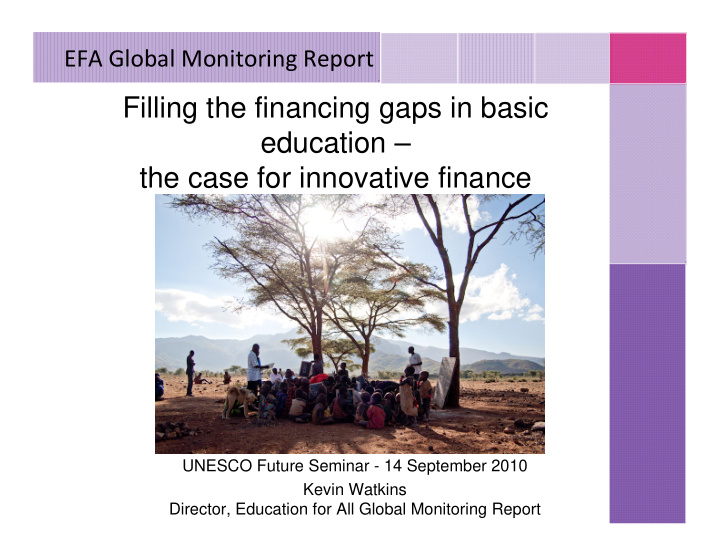



EFA Global Monitoring Report Filling the financing gaps in basic education – the case for innovative finance UNESCO Future Seminar - 14 September 2010 Kevin Watkins Director, Education for All Global Monitoring Report
Why innovative financing (IF) – and why now? Education for All Global Monitoring Report • Despite progress, EFA 2015 project is facing a crisis • Financing deficits are holding countries back • Unlike health, education is not on IF map • Key role of education for MDGs, employment, and ‘knowledge societies’ • Political momentum is gathering – and UNESCO should be seizing opportunity • IF is about more than financing – galvanising new partnerships, building momentum, links to G20 and G8
Some issues for debate Education for All Global Monitoring Report • Identify how education fits into IF ‘big picture’ and distinctive elements • Communicating the argument • Strategy-free smart arguments don’t deliver results
The EFA crisis – a snapshot Education for All Global Monitoring Report • Still 56 million children out of school in 2015 • Progress is slowing Out-of-school children Out-of-school children (millions) 120 105 million 4 Latin America and the Caribbean 100 8 Arab States Rest of the World East Asia and the Pacific 6 72 million 80 Latin America and the Caribbean South and West Asia 3 56 million 6 Arab States 60 39 million 9 East Asia and the Pacific 40 18 8 million Sub ‐ Saharan Africa 20 45 million 32 23 million 0 1999 2006 2007 2014 2015 2000 2001 2002 2003 2004 2005 2008 2009 2010 2011 2012 2013
Wider problems in equity and quality Education for All Global Monitoring Report • Child hunger undermining learning • Persistent inequalities and highly marginalised groups getting left behind • Conflict-affected states and populations face grave difficulties • Chronic problems in quality • Challenges in secondary and tertiary
The EFA financing gap Education for All Global Monitoring Report • Confusion over the ‘gap’ • GMR estimate based on adaptation of input- output model for UPE + by 2015 • Factors in ‘best endeavour’ by aid recipients • Covers three levels – Early childhood – Primary – Lower secondary • Includes estimate for reaching marginalised
The Education for All financing gap Average annual resources needed Education for All Global Monitoring Report to finance EFA (2009 ‐ 2015) US$ 36 billion 40 Aid 35 shortfall EFA $ 11 billion 30 financing gap Additional aid to 25 basic education $ 16 billion if Gleneagles 20 commitments are met Additional $ 2 billion In 2010 resources from $ 4 billion 15 prioritization $ 3 billion Current aid to basic Additional $ 3 billion education resources from 10 Estimated growth current 5 resources $ 12 billion 0
Getting left behind – aid for health and education Education for All Global Monitoring Report
High levels of innovation in health Education for All Global Monitoring Report • Global Fund – UNITAID, Red, Gates • Gavi – IFFIm bonds and Advanced Market Commitments (commercial banks) • High-level task force on IFHS • Strong focus on results and country-level action • Developed multilateral mechanisms • Some ‘vertical’ problems in skewing priorities
Current context – and EFA opportunities Education for All Global Monitoring Report • Resurgence of interest in IF linked to financial crisis, aid pressure, and MDG shortfalls • Momentum behind financial sector taxes – Welcome back James Tobin – ‘Robin Hood’ (NGOs + several governments) tax on all financial transactions – Swedish ‘stability fee’/US ‘responsibility fee’ – IMF tax on profits and bonuses • Proposals for scaling-up existing mechanisms • New options under review– from mobiles to migrants
Issues for EFA leaders Education for All Global Monitoring Report • Scale, feasibility and political attainability • Go for a twin track strategy – global MDGs plus EFA • Consider scale/efficiency Vs attribution/communication • Look beyond education to integrated MDG approach and UN political strategy on financial taxes • Identify EFA partnerships on IF (business, NGOs) • Recognise dangers of proliferating vertical funds • Aim at real new money, not repackaging, front-loading or ‘results-based’ aid conditionality • Establish credible delivery mechanisms to achieve… • ….clear human benefits
• “Any new funding mechanism and its instruments should Education for All Global Monitoring Report satisfy several criteria: – They should be related to areas that depend on or benefit from global interdependence, multilateralism and collective security; – They should be universal in outreach and applicability; – They should be able to yield financial resources commensurate to the global needs; – Their yields should be predictable and assured for a considerable period of time; – The collection of the revenue should not be cumbersome; – They should avoid economic distortions to the extent possible; – They should preserve a sense of joint “ownership” among all involved and therefore be perceived as just and equitable.” Towards a new multilateralism: Funding Global Priorities, 1995
Recommend
More recommend